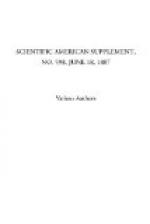The northern gallery is connected by a foot bridge with the annex of Commerce Place, where is located the colonial exhibition, the center of which is occupied by a Cambodian pavilion, in which are brought together the products of Indo-China and Algeria. For half of their extent, the two galleries are separated from the dock by a promenade provided with seats and covered with a roof. On this promenade, it became necessary to make room for certain belated exhibitors whose products are not affected by the open air.
In Commerce Dock are to be seen, floating, specimens of every ancient and modern naval construction, French and foreign, among which are the state convette Favorite and an English three-master converted into a cafe boat. We find here, too, the giant and prehistoric oak of the Rhine, on board of the Drysphore.
Commerce Dock is divided into two parts by a foot bridge, which allows the visitors to pass from one side to the other without being compelled to tiresomely retrace their steps.
The main entrance to the Exhibition is opposite the portico of the theater, on Gambetta Place. A second entrance is found on Commerce Place in the colonies annex. The others, near the center, are on Orleans Wharf, opposite Edward Larue Street, and on Lamblardie Wharf, opposite Hospital Street and opposite Saint Louis Street.
The garden of the Exhibition and the galleries that surround it are illuminated at night by the electric light.—L’Illustration.
* * * * *
OUR COAST DEFENSES.
General H.L. Abbott delivered a lecture before the Academy of Sciences in New York, on the evening of March 21, a summary of which is given by the Herald as follows:
According to General Abbott, the country needs for its coast defenses:
Heavy guns;
Armor-clad casemates;
Disappearing gun carriages
in earthworks;
Heavy mortars;
Submarine mines or fixed torpedoes;
and
Fish torpedoes.
The lecturer said that this nation may be attacked in four ways: First, by fleet and army combined, as in our revolutionary war; second, by blockading the entrances to all our ports; third, by bombardment of our seaport cities from a long distance; fourth, by a fleet forcing its way into our harbors, and making a direct attack or levying tribute on our people.
The first is not now greatly to be feared. We are too distant from great powers, and too strong on land.
The second should be met by the navy, and is, therefore, outside a discussion of coast defenses.
The third is not probable, though it may be possible. The extreme range of 10 miles for heavy guns cannot be obtained from shipboard, and as an elevation of only 15 deg. or 16 deg. can be given, not over 5 to 6 miles range is attainable.
The fourth is the one which is possible, probable, even certain—if we have war before we have better defenses.




